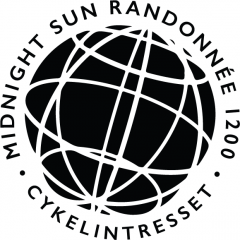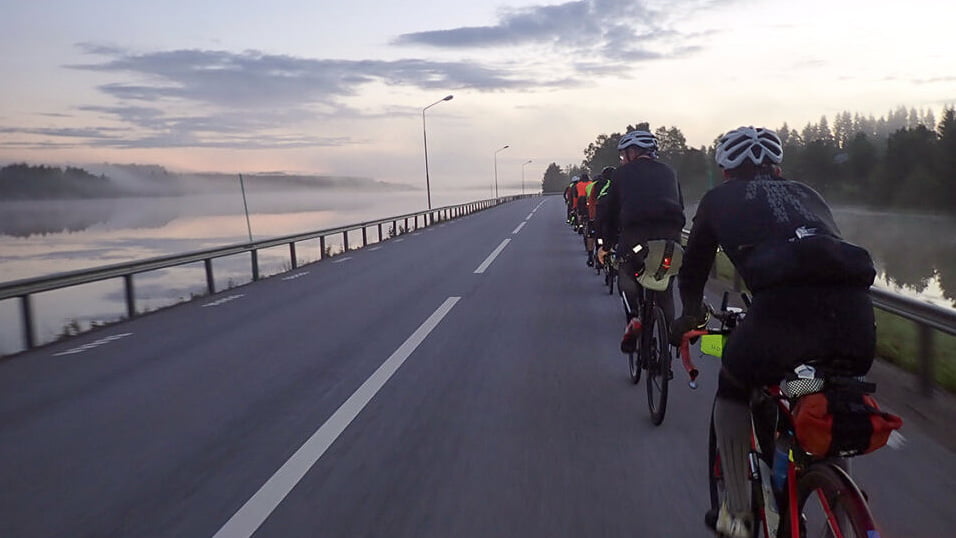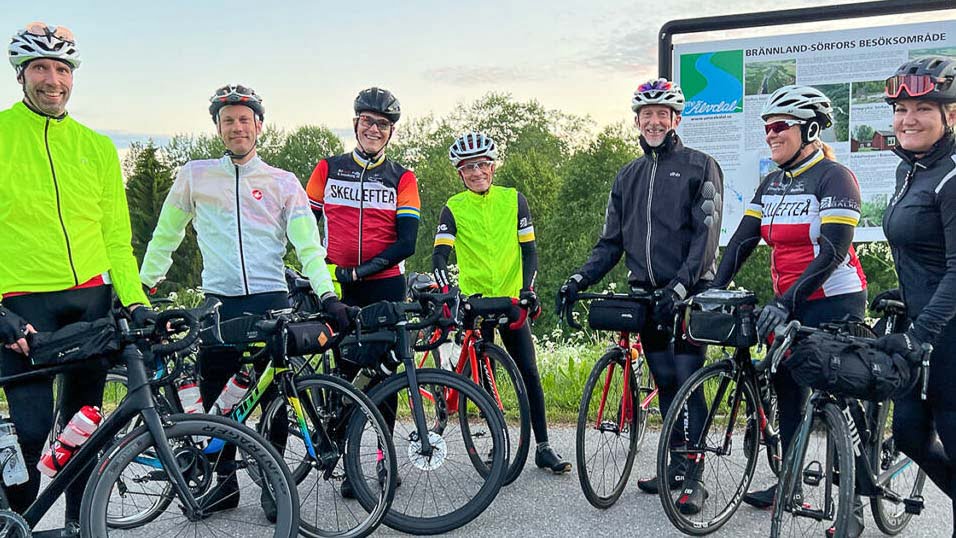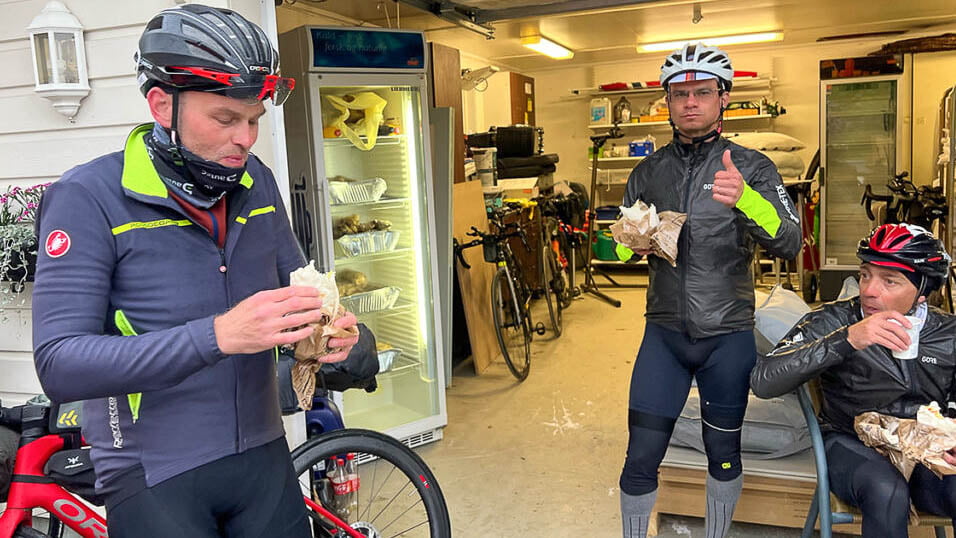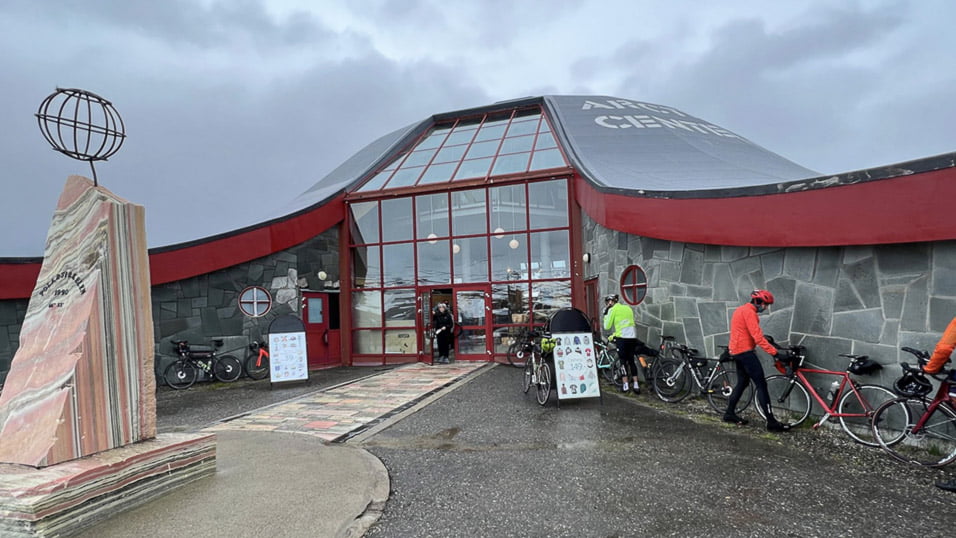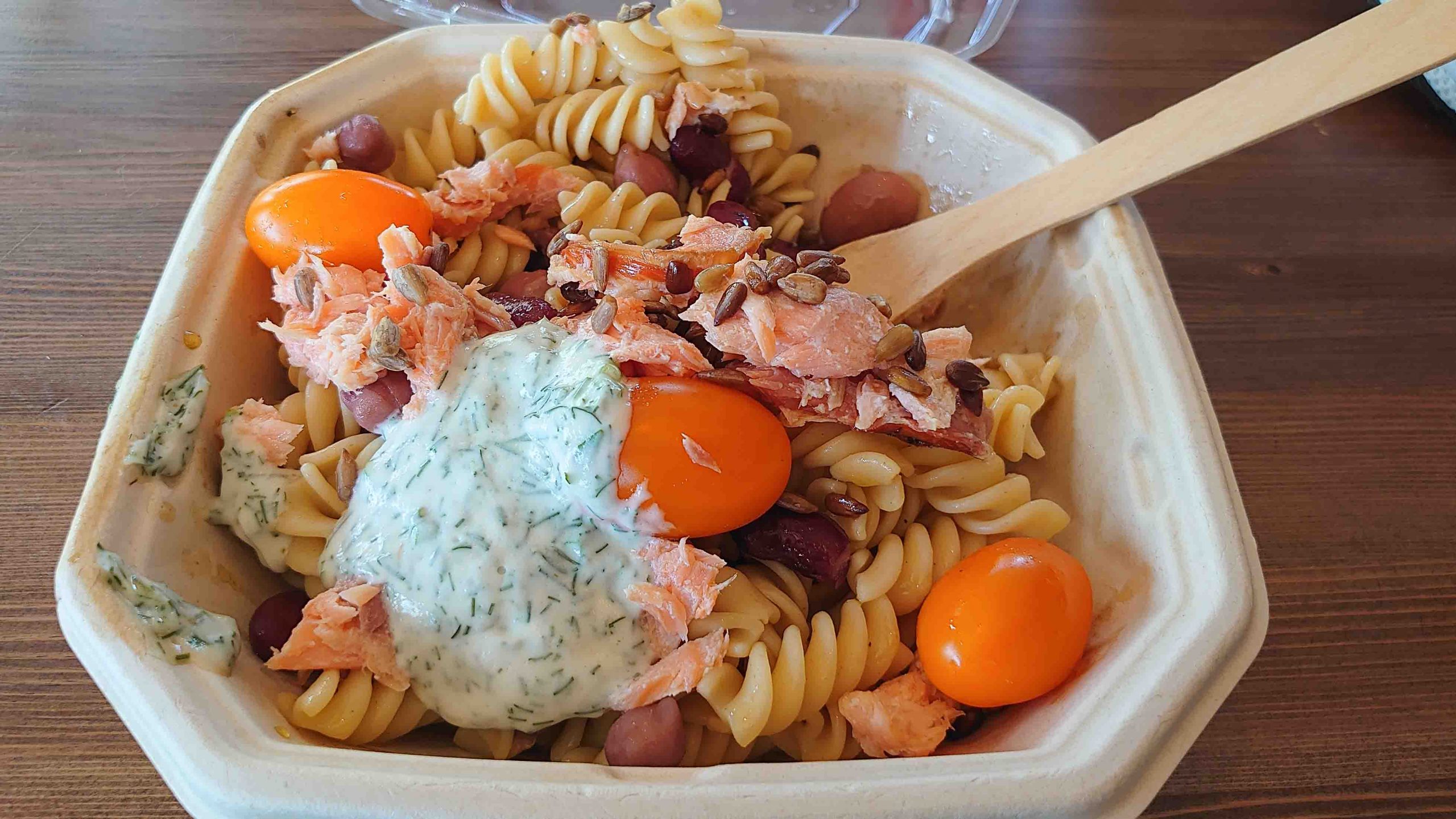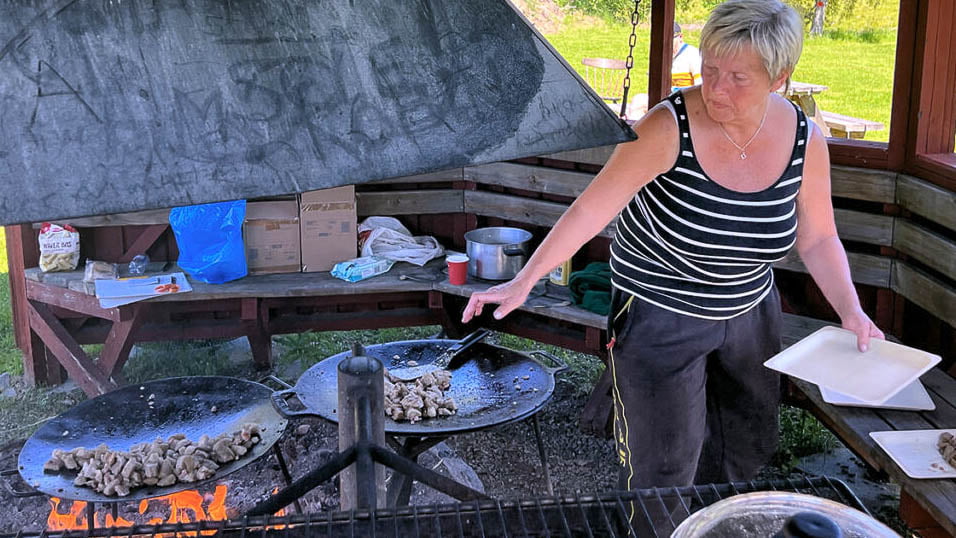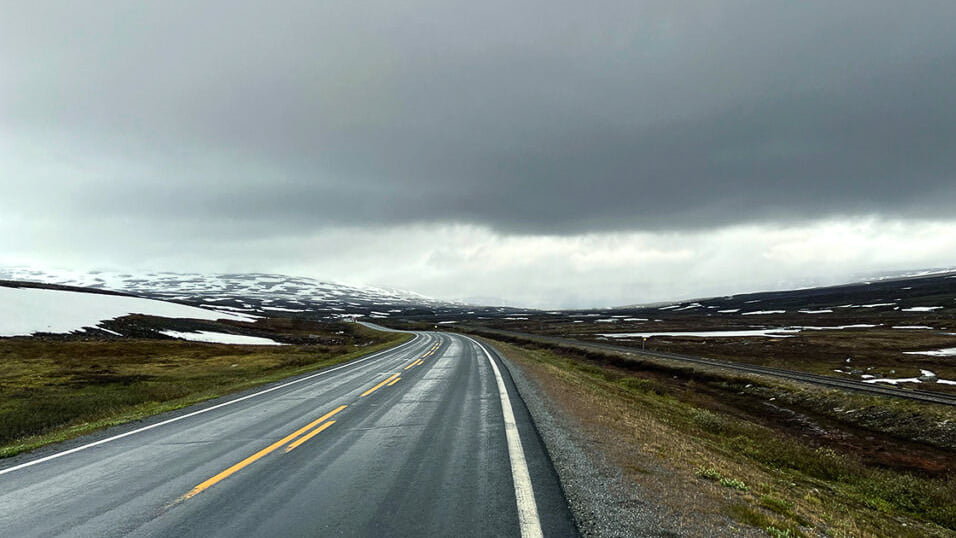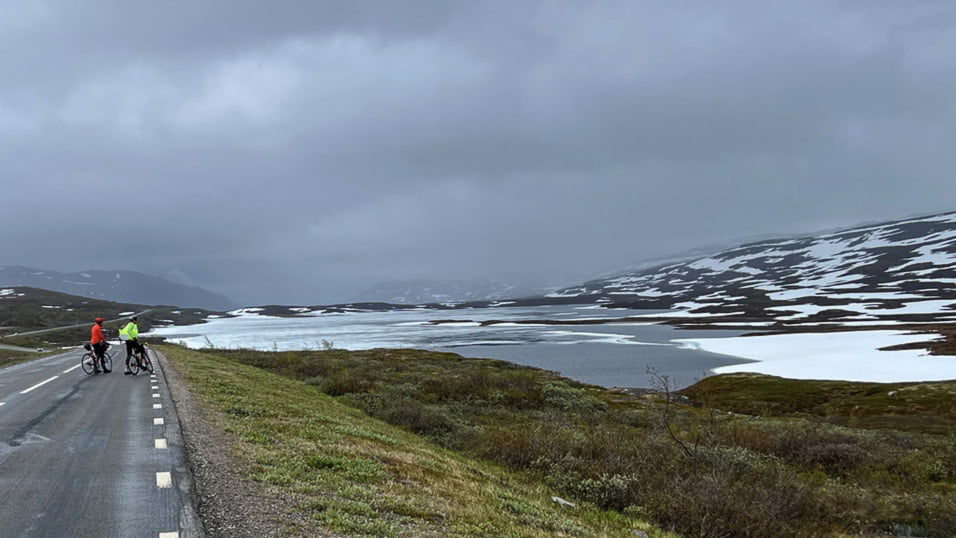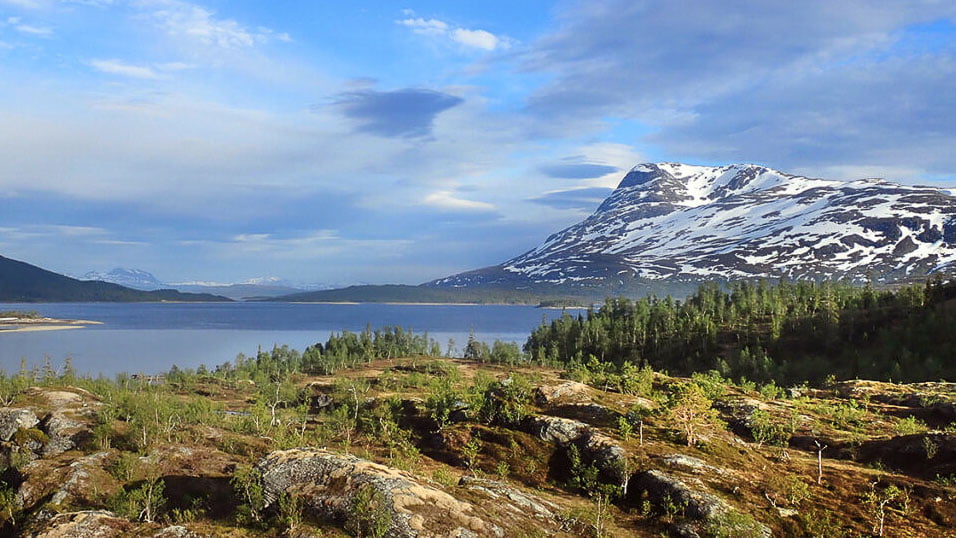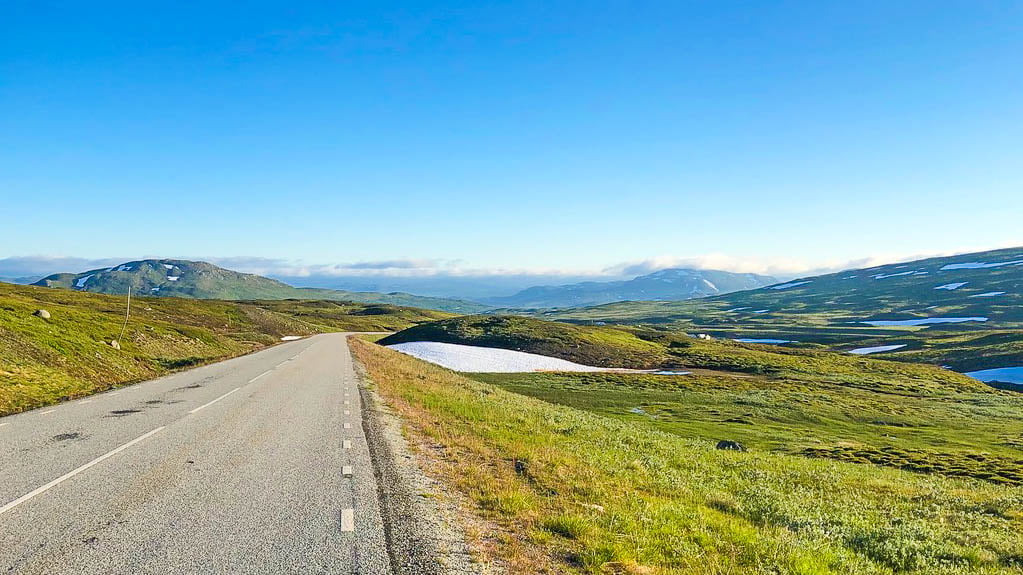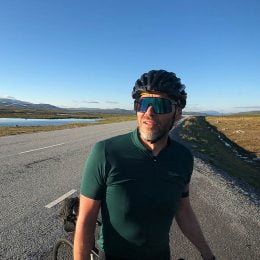The Midnight Sun Randonnée is a 1,200 kilometre ultra distance event. It takes cyclists through the Arctic Circle, cycling across northern Sweden and Norway.
The first Midnight Sun Randonnée was in 2022; it’s returning in 2023.
In this article, we speak with Florian Kynman, a Swedish local and the organiser of the Midnight Sun Randonnée. He takes us behind the scenes of the event – which he describes as “an exploration into the arctic wilderness”.
As well as talking about the event, Florian shines a spotlight on the landscapes and cycling you find in this beautiful, remote region. So if cycling holidays are more your thing than ultra endurance events, read on to find out what it’s like to ride in the quiet, stillness of the Arctic Circle in Sweden and Norway.
In this crazy, hectic world we live in, this far-flung corner of Scandinavia has never felt more appealing.
Overview of Sweden’s Midnight Sun Randonnée
What is a randonnée?
The Midnight Sun Randonnée (“MSR”) is a type of event called a brevet (also known as a randonnée or audax).
These are long-distance cycling events on designated but unmarked routes passing through particular checkpoints. Riders have to complete the course within specified time limits but there are no prizes for coming first. They are expected to ride solo (groups may form spontaneously on route) and be largely self-sufficient. Personal support is only allowed at checkpoints.
What is Sweden’s Midnight Sun Randonnnée?
The ultra brevet Midnight Sun Randonnnée is a 1,200 kilometre round trip across the Scandinavian peninsula, between the towns of Umeå in Sweden and Mo i Rana in Norway.
The course follows river valleys, lake shores and fjords. It crosses vast coniferous forests and snow-capped mountains. It also crosses the Arctic Circle. Since the event takes place on the summer solstice, participants will experience 24-hour daylight conditions.
The event takes place in the provinces of Västerbotten and Lapland in Sweden and Helgeland in Norway.
Map of the route of the Midnight Sun Randonnée
Give us a feel for the landscape
Västerbotten, Sweden is made up of woodland, rivers and lakes. Most of its towns and agricultural areas are spread along the coast. The MSR starts in Umeå, a university town with a population of 92,000. It’s the largest urban area in Västerbotten and also in northern Sweden – which gives you an idea of how quiet this part of the world is!
The province of Lapland, Sweden, is commonly described as the last wilderness in Europe. It has vast forests and marshlands, rivers and lakes. The provinces of Lapland and Helgeland share the Scandinavian mountain range which divides Sweden and Norway.
Helgeland in Norway is known for its mountains, glaciers, fjords and islands, The 6,500 islands that make up the Vega archipelago is a UNESCO World Heritage Site.
This is a region of extremes with temperatures over the year varying between +30°C and -40°C.
The daylight also varies considerably at the Arctic Circle, from around two hours of daylight in mid winter and 24 hours of daylight during the summer months.
Why did you create the MSR?
MSR is unusual in that it has both its start and finish close to the Arctic Circle. As such, it’s one of the northernmost ultra brevets in the world.
I wanted to give cyclists the opportunity to experience the midnight sun, the wilderness and the vast landscapes shaped during the ice age in this arctic region.
Whether or not you take part in the MSR, the empty roads of this sparsely populated region offer peace and solitude and a sense of being close to nature. If you ride the MSR or at another time, in summer you can still stay at the same hotels, campsites and lodges we use in the event and complete the same route. There are also many possible detours and extensions to the MSR course if you want to base yourself in one place and make excursions from there.
I think our region has something special that experienced cyclists will love.
Explain the route across Sweden and Norway
Here is a RWGPS route file for the Midnight Sun Randonnée route:
GPX DownloadTerms of use reminder
You can find detailed checkpoint information here.
Below is my summary of the route. I’ve also included a few photos – note that they don’t necessarily match up with the checkpoint information above.
Checkpoints 1 to 3: follow the lake system of Ume River
The starting point, Brännland Inn, is located on the outskirts of Umeå about 10 km from the city centre. The initial part of the course follows the E12 (which is known as the Blå vägen = The Blue Highway) and the Ume River to Storuman which is the brevet’s third checkpoint. Having completed the first 230 km of the brevet, the cyclists arrive here around breakfast time.
Checkpoints 4 to 5: cross the Scandinavian mountain range
After Storuman the journey enters the Scandinavian mountain range, the Scandes. At the village Forsnacken the course leaves the Blue Highway and the Ume River valley on a 20 km unpaved section of the course to the village Dikanäs. From there the course then continues on road 1088, to the fourth checkpoint, the village and ski resort Kittelfjäll.
From Kittelfjäll, participants follow a narrow and very scenic mountain road and reach the Norwegian border after 61 km and later, in the afternoon, the fifth checkpoint Hattfjelldal.
Checkpoints 6 to 7: follow Ranfjorden, then head to the Arctic Circle
After Hattfjelldal, the participants are led onto a winding and hilly road which follows the shores of Lake Røssvatnet, Norway’s second largest lake. The road ends with a long but shallow descent to the village of Korgen where it connects to the European route E6.
About 7 km after Korgen, the course is at sea level again. With a view of the sea and the Ranfjord, cyclists are led on the E6 to the sixth checkpoint, Yttervik camping, about 15 km south of the port city of Mo i Rana (Mo).
After Mo, the participants leave the sea and the journey continues into the mountains again, on the E6. The course leads the riders through the Dunderland valley above the tree line up on Saltfjellet and to the seventh checkpoint which is the Arctic Circle Centre at the Arctic Circle.
Large parts of the highway from Mo to the Arctic Circle Centre has been rebuilt and resurfaced in recent years so the road surface is excellent. The climb from sea level up to the Saltfjell highway’s highest point (692m) is very easy with slope gradients generally between 2-4%.
Checkpoints 8 to 9: climb the Junkerdal valley to the highest point on the course
After the Arctic Circle, the journey continues to Junkerdal, where cyclists leave the E6 and begin a more substantial climb up to the Swedish border.
Highway 95 is the only national highway (A-road) that crosses the Scandes above the tree line and about 8 km after the border the course reaches its highest point at 740 m above sea level. From here, the journey continues down to SMHI’s (Swedish Meteorological and Hydrological Institute) weather station in Mierkenis and then further on to Lake Tjaktjaure (513m) and Sandviken Mountain Lodge, which is the brevet’s eighth checkpoint. Here, we are still north of the Arctic Circle so the sun will stay above the horizon all night. In addition to sleeping arrangements this checkpoint also has a tiny grocery store.
From Tjaktjaure the course continues down to Arjeplog and the ninth checkpoint Hornavan Hotel, located on Lake Hornavan (426m), which is Sweden’s deepest lake with a depth of 221 m. In Arjeplog you will find the famous Silver Museum which is well worth a visit.
Checkpoints 10 to 11: follow the Vindel River downstream
After Arjeplog, the journey heads south on road 609 to Slagnäs where the course connects to European route 45 (the Inland Road). From Slagnäs, participants will follow the Inland Road to Sorsele and the tenth checkpoint Sorsele Community Centre, the last checkpoint with organised sleeping arrangements.
From Sorsele, the journey continues 28 km on the Inland Road to road 363 which follows the Vindel River, a tributary to Ume River which has its source in Vindelfjällen, the Vindel Mountains. Vindelfjällen Nature Reserve is one of the largest protected areas in Europe.
Road 363 leads down to the brevet’s eleventh and final checkpoint which is Åmsele Camping in Åmsele. Here a famous dish “Palt” is fried over an open fire and served with lingonberries and butter.
The finish
From Åmsele, the journey continues past Hällnäs and Vindeln on road 363, Sweden’s longest county road, to the village Rödånäs where the course turns off onto road 628 and then continues to follow the Vindel River down to the village Spöland where it flows into Ume River.
Cyclists once again cross the Ume River and the fields and meadows south of Vännäsby. Just before Sörfors, participants are led past Stornorrfors Power Station, Sweden’s second largest hydropower plant. They then follow the southern banks of the Ume River the remaining 15 km down to Umeå where they cross the Ume River one last time on The Old Bridge before arriving at the finishing line, the Hotel Scandic Plaza Umeå.
How fit do you have to be to cycle Sweden’s MSR?
MSR has a demanding course profile. Also the region’s subarctic climate can be a decisive factor. If you are not an experienced randonneur it is important that you make a realistic assessment of your chances of completing the brevet before you register.
If you have completed a brevet series or a corresponding ultra-distance race during the past two years then there’s a good prospect you will finish this brevet. If you don’t have the above qualifications, it’s advisable to do a 400 km brevet during the spring leading up the event. This will be a good indicator of your chances.
Even if the MSR is not for you – I really encourage you to consider a trip here and ride at your own tempo.
What support is provided?
If you have ridden sportives but not brevets/randonnées before, be aware of the difference from a support perspective: sportives are generally organised as supported non-competitive events on well signposted or closed roads whereas brevets are normally unsupported.
An exception to this general rule is that ultra brevets do tend to offer support at checkpoints, but the riders still need to find their way to these checkpoints on a course that is normally not signposted. There are no support vehicles or event officials between checkpoints.
What to expect at checkpoints
This ultra-distance event is an exploration into the arctic wilderness and aims to capture this experience and the solitude with nature. Riders are therefore expected to carry all requisite equipment on their bikes from start to finish. The event has no bag drop service on route.
There are warm and cold meals, snacks and beverages at all checkpoints on route. Meals are also served during the day before the start and after the finish.
In this part of the world, food stores are few and far between so it is important to refill water bottles and stock up on snacks and food before leaving each checkpoint.
Some checkpoints may also offer mechanical services with spare parts for sale.
We have booked a limited number of beds at seven checkpoints for riders who want to take short naps. Most checkpoints have things like showers and drying facilities.
Food included in the entry fee
Here’s an overview of the food menu during MSR 2022.
During the day before the event, riders were served the Austrian dish Kaiserschmarrn with a Swedish touch: scrambled pancakes served with blueberry jam. In the evening they ate a buffet dinner at the start location Brännland Inn with baked chicken fillet, sausage from a local charcuterie, bulgur salad, two varieties of pasta salad, a potato salad and also a mixed green salad bean salad.
After the start, riders stopped at a secret checkpoint between the start and the first official checkpoint where they ate an energy ball made from dates, blueberries, oatmeal and chocolate from Ben & Jerry together with coffee.
At the checkpoint in Lycksele, rainbow trout with glass noodle salad and red lentils was served, followed by coffee and cookies.
In Storuman the menu was marinated moose steak with a potato salad with herbs, Västerbotten cheese and roasted sunflower seeds served with gahkku (Sami hot cake) and for dessert coffee and rhubarb cake.
In Kittelfjäll riders ate a pasta bean salad with arctic char and after that a cinnamon bun with coffee.
In Hattfjelldal a Norwegian speciality was served: arctic char soup served with a focaccia bread, followed by coffee and cookies.
At Yttervik camping next to Ranfjorden riders ate a wrap with salmon and at the Arctic Circle centre there was also a wrap but this time with reindeer meat, together with lingonberry drink and coffee.
At Sandvikens fjällgård riders ate smoked moose meat and venison in a pasta salad.
In Arjeplog they had a wrap with meatballs of moose meat together with a potato salad.
In Sorsele a vegetable pasta salad with rye cake and coffee was on the menu.
And finally in Åmsele they ate the now famous palt fried over an open fire and served with lingonberries and butter.
Finishing
The registration fee also includes the RM medal which will be awarded to riders who finish the randonnée.
Tell us about the time cut-offs?
The event starts at 23:07 CEST (which is sunset in Umeå) on Monday 19 June 2023. Cyclists who maintain an average speed of 18-20 km/h (including stops) will finish between midday and afternoon on Thursday the 22nd. Riders maintaining an average speed of 14-16 km/h (including stops) will finish during the night until midday on Friday the 23rd.
The cut-off times are calculated on average speeds between 15 km/h and 13 km/h including stops.
Missing the time cut offs
Riders who arrive at checkpoints over the time limit will be allowed to continue the event but will, with exception for special circumstances, not receive an official finishing time.
Abandoning
As in all randonnées, if you abandon the event, you are responsible for your own transportation back to the starting point. However, if needed, due to the lack of public transportation between Norway and Sweden, we can assist with the connection back to Sweden.
What kit choices do you recommend for cycling in the Arctic region?
Weather considerations
Here in the Arctic region, the weather is an important consideration when deciding on kit choices. Here is some background information to help you plan:
- The meteorological definition of spring is rising daily average temperatures between 0°C and 10°C for at least seven consecutive days. Due to the latitudes of the MSR, meteorological spring is normally in late April or early May.
- Meteorological summer occurs when the daily average temperature has been at least 10°C for five consecutive days. In the mountains, meteorological spring usually turns into meteorological summer during the event, in mid-June.
- We expect daytime temperatures in the lowlands to be around 15 – 20°C, dropping to 10°C – 5°C at altitudes above the treeline.
- Night temperatures on low-lying terrain are generally 10°C – 5°C in mid June. Above the treeline, night temperatures stay around 5°C – 0°C.
- In the mountains the weather remains changeable and unpredictable even in summer.
- As for the chance of rain during the event, I’d estimate about 50%. In June this will usually be light to moderate rain, however, occasional heavy rainfall can occur. There may also be light snowfall although this will not tend to settle on the roads.
As you see above, daily temperatures will fluctuate during the event. Temperatures may reach 25°C during daytime and drop to 0°C during the night. Add to this the wind chill factor when choosing clothes for the event. An air temperature of 2°C combined with wind speeds of 15 km/h will give a wind cooling temperature of -18°C. Therefore, choose high-quality wind/rainwear and long-finger gloves that keep you warm and dry, even in the very worst of weather conditions.
Implications on kit choices
Since the event does not provide a bag drop service, the clothes you wear during the MSR must be carried on the bike from start to finish. For this reason, choose clothes that will give you as many combinations as possible instead of items that you may only use once or not at all.
I always find a system with layers of thinner garments that have different properties works best. They help you regulate your temperature during the day as you can make quick stops to remove or put on a layer. These can then be stored in your back pocket for later use.
Lined shoe covers, windproof vests, and leg and arm warmers are also good choices.
As mentioned, personal assistance such as follow cars or food depots between checkpoints are not permitted in brevets. Since the course crosses mainly sparsely populated areas, the opportunities to refill supplies can quickly become very uncertain, especially in the mountains. For this reason, it is very important that you carry enough food and drink with you on the bike to get you between checkpoints. Saddle or frame bags are extremely useful.
What tips would you give to someone wanting to do the MSR?
Google street view
Before the event, study the course in Google Street View, in particular critical road junctions and the location of the brevet’s checkpoints.
Ride efficiently
When cycling, conserve energy as much as possible. Try to keep a steady heart rate throughout the event. Imagine that you will cycle the second half of the brevet faster than the first.
Don’t stress; it’s also a waste of energy. A brevet is largely a mental test.
Don’t count kilometres. Relax and let the brevet take the time it takes. Subdivide the distance into shorter stage goals and focus on them.
Try to be organised at checkpoints as time spent here is included in your overall ride time. Plan your stops in advance and be efficient. Over time you’ll pay for the effort of riding faster in order to make up time spent at checkpoints.
Checkpoints
Don’t forget to register at the checkpoints! Check in at the checkpoints and make sure that your brevet card is signed and/or stamped before you do anything else, for instance eat or sleep!
Food and drink
Plan your food and fluid intake long-term. Do not leave a checkpoint without refilling supplies and water bottles. Always carry reserve supplies in case something unforeseen happens between checkpoints.
While pre-planned personal assistance is not allowed between checkpoints, help from residents along the course is allowed, such as refilling water bottles or repairing a bike.
These tips for food and drink are also important to consider if you’re riding in our region outside of the MSR. You need to expect your ride to be self-supported.
How do you get to and from Umea?
Umeå is situated 630 km north of Stockholm. It is roughly halfway between Stockholm and Kiruna, the furthermost town in Sweden.
Car
Travelling by car from Stockholm it’s an eight hour drive to Umeå on the E4. There are car rental services both at Stockholm Central Station and Stockholm’s Arlanda airport.
Plane
By plane from Stockholm’s Arlanda Airport the flight time is around fifty minutes. Transfer from Stockholm City to Arlanda Airport with Arlanda Express is roughly twenty minutes.
Train
By train from Stockholm City to Umeå it will take between six and half and ten hours depending on when you travel. From Stockholm Central Station and Arlanda airport there are express or night trains to Umeå. Not all trains have spaces for assembled bikes but most if not all trains and buses will allow disassembled bikes in bike bags.
Bus
At Stockholm Central Station there is a daily bus service to Umeå. Buses from Stockholm City to Umeå take around nine hours.
How do you enter the MSR?
Entries to MSR are via the website.
For the 2023 event, the registration fee is 2,500 SEK (including pre-registration fee) until 25 December 2022, then 3,000 SEK to 1st June 2023.
Pre-registration starts in October until 25 December 2022. Pre-registration fee: 200 SEK. The fee is not deducted from the registration fee.
After pre-registration, a final registration must then be made no later than the 31st December 23:59 CET (UTC+1)! On 1st January 2023 all pre-registrations that have not been converted into final registrations will be cancelled automatically!
Would you encourage cyclists to do the MSR route outside the official event?
Absolutely. This is a wonderful place to cycle, especially if you want to experience solitude and a sense of the vastness of nature. Do not come here expecting people, cafes and buildings! You’ll probably meet more reindeer than cars on some roads.
From mid June until late August the weather should be sufficiently warm and stable. It is also light most of the day.
If you plan ahead, you can arrange for food and accommodation at the hotels and campsites that are part of MSR. See contact information on our website. There are also a variety of alternative routes.
You can for instance choose Kittelfjäll as a base and leave your bike bag there before doing a week-long trip. Here are some routes that include some of the checkpoints in the MSR course.
Tip: If you are not participating in the MSR, after arriving to Umeå it is also possible to transport a bike bag on bus or train from Umeå to the mountains and to start your tour there. Suggested locations to start from, which also are easy to reach by bus or train are: Storuman, Kittelfjäll, Vilhelmina, Saxnäs, Sorsele and Arjeplog.
What is there to do before/after the MSR?
What to do in Umea
For those of us who live in Umeå, it came as no surprise when the town was elected the European Capital of Culture in 2014. Here, there is a simmering cultural life with art, theater, dance and a music scene that includes everything from hardcore and hip hop to folk music and opera.
Don’t miss a visit to the museum Guitars which has one of the world’s largest privately owned collections of electric guitars. For art lovers there is Bildmuseet, one of the country’s most interesting scenes for international contemporary art. Umeå also has the first museum of women’s history in Sweden – Kvinnohistoriskt museum.
In Umeå you are always close to nature. Hiking, trail cycling, whitewater rafting and kayaking are just a few activities offered in and around Umeå during the summer.
In the past 15 years, Umeå has gone through a restaurant-renaissance. The gastronomy scene offers everything from fine dining to cosy neighbourhood hangouts, creative cocktail bars, microbreweries and an award-winning ice cider winery. Focus is foremost on sustainable, modern and local cuisine with inspiration from the 130 nationalities represented in Umeå. A few examples of restaurants to check out are Facit Bar, Gotthards Krog, Köksbaren, Harlequin and Bodegan.
Midsummer, 24 June 2023, is the longest day of the year and a beloved tradition in Sweden. Midsummer festivities are arranged all over the country. In Umeå you can for example visit Västerbottens museum, a museum depicting the country’s history, and also Umeå energicentrum, Umeå’s first power plant from 1898-1899. These locations have a scenic environment with historic buildings, adventure playground and much more.
What to do in Mo i Rana
Mo i Rana is the largest town in the Helgeland region. It lies just outside the Saltfjellet-Svartisen National Park.
The town’s history spans from its early days as a trading post, to an era as an industrial powerhouse centred around its ironworks, to its present role as a modern mini metropolis. In Mo i Rana you’ll find excellent restaurants and cafés, a vibrant theatre, a lively music scene, interactive science museum, charming shops, large shopping centres, and more.
While you’re here, these are the things not to miss:
Underground and underwater caves – The Rana region has a large number of caves, but Grønligrotta and Setergrotta are the two that are best known and most accessible to visitors. Both are limestone-marble caves, both are in the same area, and for both you can join a guided tour. At Grønligrotta you’ll find stairs, wooden walkways, railings and electric lighting. Setergrotta has been left untouched, and visitors wear a helmet with a headlamp, coveralls and gloves.
Saltfjellet and the Arctic Circle
If you are an avid hiker and appreciate the mountain wilderness of Northern Norway, Saltfjellet is a great choice for a healthy dose of beauty and tranquillity. The Svartisen-Saltfjellet National Park covers 2,192 square kilometres, with vast mountains, valleys filled with forests, lakes and tarns. There’s also a network of hiking trails. One of the oldest is the Telegraph Trail (Telegrafruta) from Rana in the south to Saltdalen in the north. You can hike the southern part of this trail, crossing the Arctic Circle within a day. If you wish to continue but not walk the entire trail, you can stop halfway, leaving the national park near the Arctic Circle Centre.
Vitensenter Nordland – interactive science museum
This centrally situated science museum is a draw for visitors of all ages. Children love exploring various natural phenomena, our environment, human body and outer space. The interactive exhibits are designed to be explored with all your senses. Helgeland Museum and its fine exhibitions are situated in the same building.
Cycling in/around Umea
The countryside around Umeå is reasonably flat, consisting mostly of farmland and forests.
If you arrive in Umeå a few days before the event and would like to see the countryside round Umeå try this route.
The route passes Brännland Inn which is the start location for MSR. Here you can make a stop for coffee and a waffle before heading back to the hotel.
Umeå has a good bike infrastructure. Here is a map of cycling paths in Umeå.
Highway Code rules for cyclists in the region
The traffic in Umeå and the region is calm outside rush hour and cyclists are generally respected. On roads with speed limits over 80 km/h it’s a good idea to use a rear light also during the day.
Safety (on bike and off-bike) and tips
Umeå and the region as a whole is very safe. Being a university town, cycling is a common mode of transport in Umeå (even during winter) and perhaps for the same reason it’s also easy to lose your bike if you leave it unlocked outside of shops or bars, especially on weekends.
Whether bikes are allowed on public transport
Bikes aren’t allowed on the local buses.
Food to try
We try to include lots of the local delicacies within the food on the MSR – details above.
Of course, ”Palt” would be the most obvious dish to try. If you like sea food you can cycle to Rovögern on the coast. Here you’ll find a fish restaurant called Kvarkenfisk. If you want to test your boundaries I suggest you try ”Surströmming,” fermented herring. Like an aged cheese, the smell is much worse than the taste.
Do you need to know Swedish?
A majority of the population in Sweden and Norway speak English, but if you want to impress the locals try saying ”Hej” meaning ”Hello” and ”Tack” meaning ”Thank you”. The words are the same in Norwegian.
General tourist information
Check out these sites for tons of information:
Visit Helgeland = www.visithelgeland.com/en
Visit Umeå = www.visitumea.se/en
Visit Västerbotten = www.visitsweden.com/where-to-
A big thank you to Florian and the Midnight Sun Randonnée organisers for this insight into this very special part of the world!
Thanks also to the MSR participants who took, shared and allowed us to use the photos you see in this article, including Lukas Thierau, Marijke De Prez, Alan Silva, Mikko Mäkipää and Florian Kynman.
Got a question for Florian?
Fill out this form and we will send it to Florian. We aim to get you an answer within 24 hours wherever possible!
The contents of this website are provided for general information purposes only. It is not intended to amount to advice and you should not rely on it. You should carry out your own due diligence and risk assessments and take professional advice. Views expressed by interviewees or other users of this website do not necessarily represent our views. We make no representations, warranties or guarantees, whether express or implied, that the content on our website is accurate, complete or up to date. If you use any information or content on this website, download from, or otherwise obtain content or services through our website, it is entirely at your own discretion and risk. Epic Road Rides Ltd disclaims all liability and responsibility arising from any reliance placed on the information and content on this website. Find out more here.

